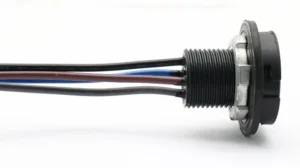Smart Photocells: Enhancing Street Light Control Systems
Street lighting serves as a cornerstone of urban infrastructure, ensuring safety, security, and visibility in public spaces. Traditional street light control systems, however, often fall short of meeting the evolving needs of modern cities.
According to a study from Wuhan University of Technology, regular street lights don’t have real-time monitoring. They can only be controlled manually or set on a basic timer, resulting in low energy efficiency and making management and maintenance difficult. This has spurred the integration of advanced technologies like smart photocells, revolutionizing the way we illuminate our streets.
This article delves into the transformative role of smart photocells in street light control systems. From energy savings to adaptive lighting, this exploration aims to shed light on the future of urban illumination.

Understanding Smart Photocells
Smart photocells represent a technological leap in street lighting control. These devices go beyond conventional photocells, incorporating intelligent features like photocontrol that enable dynamic adjustments based on environmental conditions.
The fundamental functionality lies in their ability to autonomously respond to changes in ambient light, weather, and other variables, ensuring optimal illumination while minimizing energy consumption.
Multiple variables of photocells are available in the market, including button photocell, 120-volt photocell, longjoin photocell, and shangai long join.
Evolution of Street Lighting
Street lighting, historically reliant on conventional technologies, has undergone a transformative evolution. In the early days, gas lamps illuminated city streets, giving way to electric bulbs in the late 19th century. However, conventional street light control systems face challenges such as inefficiency, limited adaptability, and increased energy consumption.
As urban landscapes expand and environmental concerns grow, the demand for smarter solutions becomes evident. This evolution highlights the necessity for innovative technologies like smart photocells to address the shortcomings of traditional street lighting and usher in a more sustainable and efficient era.

How Photocell Light Switch Differ from Traditional Photocells
Unlike traditional photocells, which are limited to static control mechanisms, smart photocells introduce adaptability and intelligence. Traditional counterparts rely on fixed schedules or manual adjustments, whereas smart photocells continuously analyze real-time data to determine the most efficient lighting levels.
This key distinction enables a more responsive and energy-efficient approach to street lighting, catering to the dynamic nature of urban environments.
Key Features and Capabilities of Photocontrol
Smart photocells by ChisWear boast a range of features that set them apart. These include real-time monitoring, remote control, and data analytics. The ability to communicate with central control systems allows for seamless integration into smart city frameworks.
Additionally, these devices often come equipped with predictive maintenance capabilities, further reducing downtime and enhancing the overall reliability of street lighting networks.
Evolution of Street Lighting
Street lighting, historically reliant on conventional technologies, has undergone a transformative evolution. In the early days, gas lamps illuminated city streets, giving way to electric bulbs in the late 19th century. However, conventional street light control systems face challenges such as inefficiency, limited adaptability, and increased energy consumption.
As urban landscapes expand and environmental concerns grow, the demand for smarter solutions becomes evident. This evolution highlights the necessity for innovative technologies like smart photocells to address the shortcomings of traditional street lighting and usher in a more sustainable and efficient era.
Benefits of Photocell Street Light
The importance of smart photocells in street lightning is inevitable. A research study published in the Borneo Journal of Sciences and Technology concludes that smart approaches in conventional street lighting could save up to 48% of energy.
However, there are multiple other benefits that smart photocells have to offer. These includ
Energy Efficiency and Cost Savings
Smart photocells revolutionize energy consumption by dynamically adjusting light levels based on real-time needs. This adaptive control not only optimizes energy usage but also leads to significant cost savings, reducing the financial burden on municipalities and communities.
Adaptive Lighting Based on Environmental Conditions
One of the key advantages of smart photocells is their ability to respond to environmental factors such as ambient light, weather conditions, and pedestrian activity.
This adaptive lighting ensures that streetlights operate at optimal levels, enhancing visibility and safety while minimizing unnecessary energy consumption during well-lit periods.
Improved Maintenance and Reduced Downtime
Smart photocells introduce predictive maintenance capabilities, allowing for the proactive identification of issues before they escalate.
This not only streamlines maintenance efforts but also reduces downtime, ensuring that streetlights operate reliably and contribute to a safer urban environment.
Contribution to Sustainability and Environmental Impact
By promoting energy efficiency and reducing light pollution, smart photocells play a pivotal role in fostering sustainability. Their precision in controlling illumination minimizes environmental impact, aligning with the global push for eco-friendly urban solutions.
Through these advancements, smart photocells contribute to building environmentally conscious and resilient communities.
Adaptive Lighting Based on Environmental Conditions
One of the key advantages of smart photocells is their ability to respond to environmental factors such as ambient light, weather conditions, and pedestrian activity.
This adaptive lighting ensures that streetlights operate at optimal levels, enhancing visibility and safety while minimizing unnecessary energy consumption during well-lit periods.
The Role of the Internet of Things (IoT) in Street Lighting
The integration of smart photocells with the Internet of Things (IoT) marks a paradigm shift in street lighting management. IoT enables seamless communication between devices, allowing smart photocells to share real-time data with centralized control systems.
This connectivity enhances overall system intelligence, enabling more precise control, monitoring, and data-driven decision-making.
Smart City Initiatives and the Integration of Smart Photocells
Within the broader context of smart city initiatives, the incorporation of smart photocells represents a critical component. Municipalities worldwide are embracing the concept of smart cities, where interconnected technologies enhance urban living.
Smart photocells play a pivotal role by contributing to energy efficiency, reducing operational costs, and aligning with the overarching goals of creating sustainable, technologically advanced urban environments.
The integration of smart photocells into smart city frameworks showcases a commitment to innovation, efficiency, and the well-being of urban communities.
Common Challenges in Implementing Smart Photocells
Implementing smart photocells presents challenges, including initial infrastructure costs, interoperability issues, and the need for skilled personnel. Additionally, concerns related to data security and privacy may arise, requiring careful consideration during deployment.
However, ongoing technological advancements are mitigating challenges associated with smart photocell implementation. Improved connectivity protocols, standardized interfaces, and interoperable systems facilitate seamless integration.
Furthermore, enhanced cybersecurity measures and user-friendly interfaces contribute to the widespread acceptance and successful deployment of smart photocells.
Future Prospects and Innovations in Street Light Control Systems
The future of street light control systems is promising, with continuous innovation addressing existing challenges. Anticipated advancements include more robust data analytics, artificial intelligence-driven decision-making, and the integration of renewable energy sources.
As technology evolves, street light control systems will likely become even more efficient, cost-effective, and environmentally friendly, paving the way for smarter and more sustainable urban landscapes.
Conclusion
In conclusion, the integration of smart photocells marks a pivotal shift in the landscape of street lighting. As cities strive for efficiency, sustainability, and technological advancement, these intelligent devices offer a beacon of progress.
From dynamic energy optimization to seamless integration with smart city initiatives, smart photocells promise a brighter, more adaptive future for urban illumination.
External Links
- https://www.sciencedirect.com/science/article/pii/S1877050919310221#~:
text=Traditional%20street%20light%20control%20systems,inconvenience%20to%20management%20and%20maintenance. - https://www.census.gov/newsroom/stories/incandescent-light-bulb.html
- https://www.researchgate.net/publication/339309759_An_Energy-efficient_Smart_Street_Lighting_System_with_Adaptive_Control_based_on_Environment https://www.iotforall.com/use-case/smart-lighting





